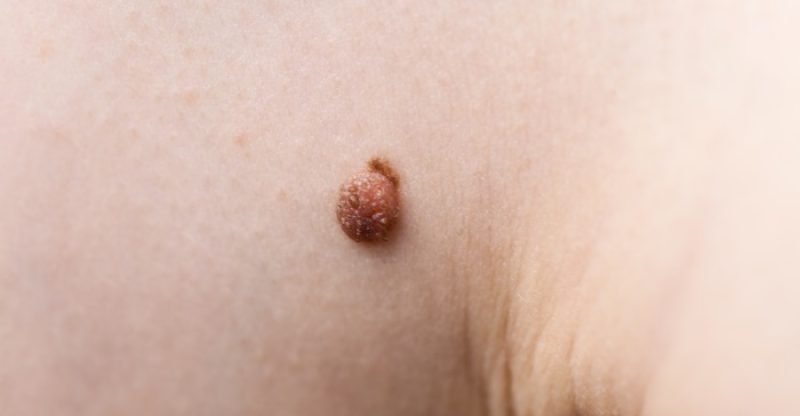14 Science-Backed Natural Ways to Remove Skin Tags
If you have ever had a skin tag, you know they can be embarrassing, inconvenient, and even cause occasional irritation.
Treating these soft, fleshy growths is likely something your insurance does not cover, as they are really a cosmetic problem.
But the good news is it is easy to deal with skin tags at home using natural remedies.
Our guide shares with you everything you need to know about skin tags, including the very best natural treatments for removing these unsightly bits of skin.
If you want to learn how safely and effectively to remove a skin tag at home, keep reading to learn the cost-effective and easy solutions you can use yourself for removing skin tags.
But first, let’s be sure you understand how to identify a skin tag properly so that you do not confuse it with a mole, freckle, or other skin growth.
Then we will see what causes skin tags, so you will know how best to prevent them from developing.
What are Skin Tags?
Physicians or dermatologists refer to skin tags as acrochordons.
The noncancerous bits of skin can resemble tiny growths or flaps that protrude from the skin’s surface.
Most skin tags are the same color as the rest of your skin, but they can also be slightly darker.
Rarely, skin tags can grow large; most, however, remain small, usually less than two centimeters.
Because skin tags are benign or pose no harm or threat, they do not have to be treated.
However, if the skin tag is in a very noticeable location, or someplace that experiences lots of friction, you may want to remove the skin tag either to improve your appearance or to ease any irritation it may cause.
The small flaps of tissue that hang from your skin, known as skin tags, usually remain small.
Some, though, may grow as large as five centimeters.
Skin tags often form in places where moisture and friction frequently occur, such as in folds of skin, around the genitals, in the armpit, under breasts, on the neck or torso, or near your eyelids.
Skin tags can become irritated by the friction caused by jewelry or clothing, but they usually cause no pain (1).
If a skin tag becomes twisted, you can develop a small blood clot that becomes painful or tender.
This, though, usually resolves in a few days.
Many people actually have skin tags but are completely unaware that they do.
Often, these growths will simply fall off on their own, due to natural friction from your everyday movements.
When they do not come off by themselves but instead grow larger in size, they become more noticeable, and possibly more irritated.
Skin tags resemble mushrooms, with a skin stalk and a floppy top.
They are usually flesh-colored or slightly darker than your normal skin.
What Causes Skin Tags?
There is no definitive cause identified for skin tags.
There are several factors that can raise your risk for developing these skin lesions, though.
These include (2):
- Gender. Females are more likely to develop skin tags.
- Age. As you age, you are more likely to develop these skin lesions.
- Weight. Weight gain is a common precursor to developing skin tags.
- Friction. The most common areas for developing skin tags are those that are consistently rubbed by other skin, clothing, or jewelry.
- Genetics. If others in your family have skin tags, you are more likely to develop them, as well.
- Medical conditions. Some diseases that create imbalances in hormones or cause metabolic dysfunction can increase your risk of having skin tags. These include polycystic ovary syndrome (PCOS), diabetes, and high blood pressure (3).
When to See a Doctor?
Any changes in your skin can be cause for concern, and your doctor or dermatologist should examine any new moles or skin tags you may find.
This is important because you do not want to miss early warning signs of skin cancers, like squamous cell carcinoma, basal cell carcinoma, and melanoma.
Examine your skin regularly to be aware of any changes.
If you find areas of concern, take photographs, so that you can note and track variations with ease.
Talk to your doctor if you have a skin lesion that is dark, discolored, has changed in size or shape or is bleeding.
If you have a history or family history of skin cancer, if you live at a higher elevation or near the equator, or if you have many moles, you should see your dermatologist at least once a year to monitor your skin.
Remember that skin tags are benign and cause no harm, but you do not want to confuse this type of skin lesion with something more serious.
Once your doctor or dermatologist has confirmed that what you have is a skin tag, you can select the best treatment option for you.
Treating Skin Tags Conventionally
Once your doctor or dermatologist has examined your skin, she or he can determine if you have a skin tag or some other type of skin lesion.
If a physical exam is not able to determine this conclusively, your doctor may order a biopsy to rule out the possibility of skin cancer.
Depending on the location, condition, and size of your skin tag or tags, your doctor may opt for one of several treatment options.
Remember to discuss all side effects and possible scarring for each one before proceeding.
Not all insurance plans will cover the removal of skin tags, so always check if yours will before agreeing to treatment, as well.
It is important to remember that all skin tags have a blood supply, so any procedure to remove them should be done to minimize bleeding and possible scarring.
You should never attempt to cut, burn, or freeze a skin tag on your own at home.
The most common skin tag treatment options from your doctor include:
- Surgery – This involves the use of a scalpel to cut away the skin tag. Usually, a bit of topical anesthetic is used to numb the area, and you may have a small scar where the skin tag was removed.
- Cauterization – This medical procedure uses a special tool that heats, and essentially burns, the skin tag off your body. The skin tag may not fall off immediately but instead may fall away several days after the procedure.
- Cryotherapy – This procedure uses liquid nitrogen to freeze the tag, which will then fall off. Cryotherapy works well in areas with no hair, or for lighter skin (4).
- Lasers – Most commonly, a CO2 laser is used to remove skin tags in the doctor’s office or clinic. As with other procedures, a topical anesthetic is usually given to numb the skin (5).
Treating Skin Tags Naturally
Removing skin tags at home can be simple and inexpensive, but be cautious of remedies that use strong chemicals, or call for cutting or ripping the skin tag from your body.
These are not safe and can cause additional problems for your skin.
As a reminder, skin tags should not be frozen, cut, or burned off at home.
Not only could this result in bleeding and scarring, but you can also develop an infection from these types of at-home treatments.
There are many safe, natural treatments that will effectively remove skin tags without causing you harm or damage, and these options are much better for your health, as well as your skin.
When selecting a natural treatment for removing skin tags, consider the tags’ location when you make your choices.
Not all treatments are appropriate to use on any part of your body.
Skin tags around the eye should always be removed by a dermatologist, as your eye is both extremely sensitive and very important.
Remember that you want to know for sure that what you have is a skin tag before you try to remove it yourself.
Moles and other skin lesions should not be removed at home, and you want to be sure you know what you are treating before you begin.
These natural treatments are all effective, but they do take time to work properly.
Have patience and know that, in time, your skin tag will be removed safely using these natural remedies.
Apple Cider Vinegar
Apple cider vinegar has medicinal properties that make it excellent for treating many problems and ailments.
For treating skin tags and other dermatological problems, apple cider vinegar’s antibacterial and antifungal properties make it a good choice.
Use organic vinegar that includes the “mother,” for best results.
To use, soak a sterile cotton pad in apple cider vinegar.
Place the pad on the skin tag, then cover with a bandage for 20 minutes.
If you experience no irritation after the initial treatment, continue with this 20-minute treatment once each day.
You can also leave the soaked cotton on overnight if your skin tolerates the vinegar.
As your treatment progresses, the color of the skin tag will darken.
This lets you know that your treatment is working.
It can take up to a few weeks for the skin tag to die completely and fall off but have patience, and this treatment can be highly successful.
Tea Tree Oil
Tea tree oil is another popular remedy for treating skin tags and other skin problems, like acne, psoriasis, and eczema.
Tea tree oil is a natural antifungal and antiseptic, which makes it a natural choice for removing skin tags (6).
To use tea tree oil, start with a sterile cotton pad, and add six drops of the oil.
Secure the cotton to the skin tag using a bandage.
Allow sitting for 15 minutes before removing.
Repeat this process three times per day, until the tag falls off.
Depending on the size and location, this could take a few weeks.
As with all the remedies recommended here, if your skin does not tolerate the tea tree oil, discontinue use.
If you notice itching, redness, or discomfort, choose a different treatment option.
Dandelion Sap
Dandelions are more than just lawn weeds.
The health benefits of dandelions are numerous, including in the removal of skin tags.
The high concentration of minerals and vitamins in dandelions may help break down the tissue in skin tags and remove these growths.
To harvest fresh dandelion, remove the plant carefully from the ground to keep the root intact.
Squeeze the root gently, which will extract the sap, which is what you want to use.
The sap should be applied directly to the skin tag at least three times per day for best results.
Coconut Oil
The natural compounds in coconut oil make it beneficial for your skin in many ways.
The lauric acid that the oil contains dissolves the cellular walls of many different microbes (7).
To use, apply coconut oil to your skin tag, then rub the oil in.
Do this just before bed each night and, within a few weeks, you should notice that your skin tag is much smaller, or has completely disappeared.
Oil of Oregano
Oil of oregano is another popular skin care treatment.
Not only does it reduce inflammation, but the oil is also antimicrobial, which can help with many skin issues.
Oregano oil can irritate skin, so be sure to mix it with a carrier oil such as almond, jojoba, or coconut oil.
Try a mixture of one part oregano oil to two parts carrier oil.
If this irritates your skin, you can dilute it further.
Apply the mixture to your skin tag three times a day, allowing the oil to absorb into your skin without a bandage or cover.
Do not use this remedy on skin that is irritated or broken.
Iodine
Iodine is effective at breaking down the cells of skin tags, and applying iodine directly to your skin tag can be quite effective.
Be sure to put iodine only on the skin tag and not the healthy, surrounding tissue.
You can create a barrier for your healthy skin by placing coconut oil around your skin tag, then using a cotton swab to apply the iodine twice daily directly to the tag.
Manuka Honey
Manuka honey, which comes from New Zealand and parts of Australia, is used for many medicinal purposes.
This type of honey can restrict the supply of oxygen to a skin tag, which will cause it to wither, die, and fall off.
This honey also has antimicrobial properties, which can help your skin heal, too (8).
Apply the honey directly to your skin tag, then cover with a bandage.
Repeat this method several times a day, until the skin tag falls off.
Garlic
Garlic has been used to treat warts and other skin lesions for centuries.
The oils in garlic are antiseptic, reduce inflammation, and can also help dissolve the skin tag (9).
Crush a clove with the blade of your knife, place this on your skin tag, then cover with a bandage.
Leave overnight, repeating the process daily.
While this treatment has a pungent smell, it is also very effective at removing unwanted skin tags.
Vitamin E
Vitamin E is a natural, effective treatment for many skin ailments, including skin tags.
Vitamin E is very popular for skin use, and it is even included in many skin care products.
Use high-quality Vitamin E oil.
Apply the oil directly to your skin tag, then cover this with plastic wrap and a bandage.
This will keep the oil next to your skin, where it can work effectively.
Allow sitting overnight.
Banana or Papaya Peels
The peels of both banana and papaya fruits have compounds that can help remove a skin tag.
For best results, use peels in conjunction with tea tree oil.
This combination is excellent for helping the skin tag to die and fall away.
To use, place a few drops of tea tree oil on your skin tag, cover with a small piece of banana or papaya peel, then secure in place with a bandage.
Do this just before bed, and allow it to work overnight.
Repeat each night until your skin tag disappears.
If you are sensitive or allergic to latex, this treatment may cause a reaction, so test this method before using for extended periods.
Baking Soda and Castor Oil
The combination of baking soda and castor oil is an effective, natural treatment for removing skin tags.
Castor oil and baking soda have long been a part of natural medicine, and when combined, these two ingredients work powerfully together (10).
These ingredients can also be combined with the last treatment to create an effective skin tag remover.
To use, mix one part baking soda with two parts castor oil.
Rub the mixture gently into your skin tag, then cover with a small piece of plastic wrap or a small piece of banana or papaya peel.
Cover with a bandage and allow to sit overnight.
Rinse well in the morning, repeating nightly until the skin tag is removed.
Epsom Salts
You can use Epsom salts to draw out the toxins in your skin and balance pH, which can dry out your skin tag and cause it to fall off.
In addition, Epsom salt baths are relaxing, and good for your skin.
There are two methods that can be used with Epsom salts.
The first should be done every other day.
Create a warm bath using one cup of Epsom salts, creating a salt-water bath in which you can soak for up to 20 minutes.
To create a daily treatment, add one-half teaspoon of Epsom salts to two tablespoons of water.
Dissolve the salts completely, then soak a cotton square in the solution.
Place this on your skin tag, secure it with a bandage, and allow to sit for 15 minutes.
This procedure can be done up to two times per day.
Cinnamon
There is some evidence that both higher levels of blood glucose and diabetes increase your risk of developing skin tags.
If you have diabetes and develop skin tags, you can prevent new ones from forming by taking cinnamon supplements.
Cinnamon is an excellent treatment for stabilizing blood glucose levels, and this supplement is also an excellent option for preventing future skin tags (11).
Lower Blood Sugar
Eating a diet that helps lower your blood glucose levels can also help prevent future skin tags from forming.
If you have diabetes or an endocrine or metabolic disorder, eat a diet of whole foods, including lots of vegetables, fruits, legumes, healthy fats, and lean proteins.
Precautions
Changes to your skin should be examined by a physician to rule out skin cancer or other skin problems.
Never attempt to remove a skin tag until a doctor has confirmed that that is what you have.
Skin tags are benign skin growths that usually cause no symptoms or problems.
They may become irritated by friction from clothing, other skin, or jewelry.
The most common areas for a skin tag to develop include under the arms or breasts, in the groin region, around the eyes, and on the neck or torso.
When you are treating a skin tag, it is important not to pick at the tag or any scab that may remain after it falls off.
This will reduce your risk of infection and scarring.
Never attempt to cut, scrape, burn, or freeze a skin tag on your own.
These procedures should only be performed by a doctor.
Discontinue any treatment that results in bleeding, irritation, or pain.
Always have a doctor treat any skin tags that are on the eyelid or around the eye.
Remember that it is not necessary to remove skin tags, and most people do not treat their skin tags in any way.
Natural treatments can be very effective at removing skin tags, but they take time to work properly, so be patient.
The most effective natural treatments for skin tags include apple cider vinegar, tea tree oil, Manuka honey, coconut oil, dandelion sap, oil of oregano, Vitamin E, garlic, iodine, banana peels, baking soda, cinnamon, and Epsom salts.
FDA Compliance
The information on this website has not been evaluated by the Food & Drug Administration or any other medical body. We do not aim to diagnose, treat, cure or prevent any illness or disease. Information is shared for educational purposes only. You must consult your doctor before acting on any content on this website, especially if you are pregnant, nursing, taking medication, or have a medical condition.
HOW WOULD YOU RATE THIS ARTICLE?






